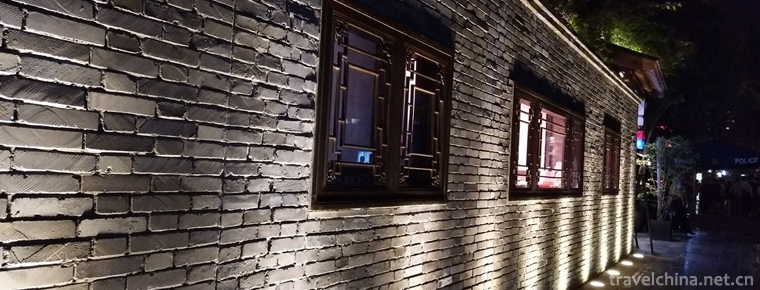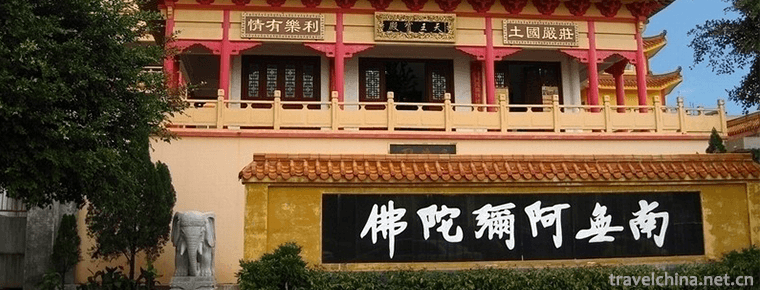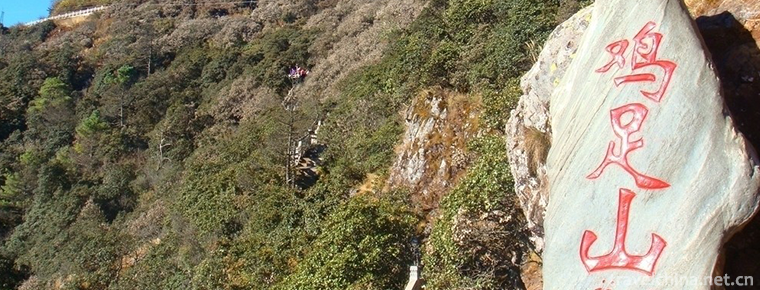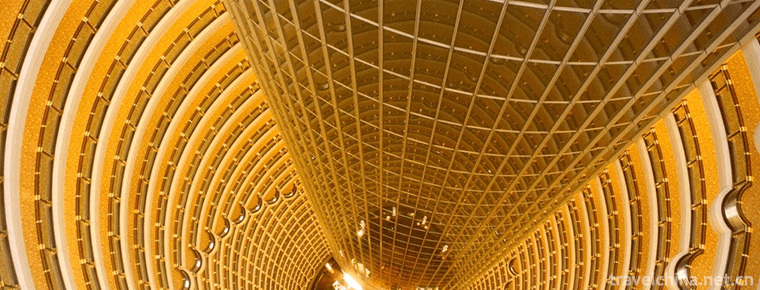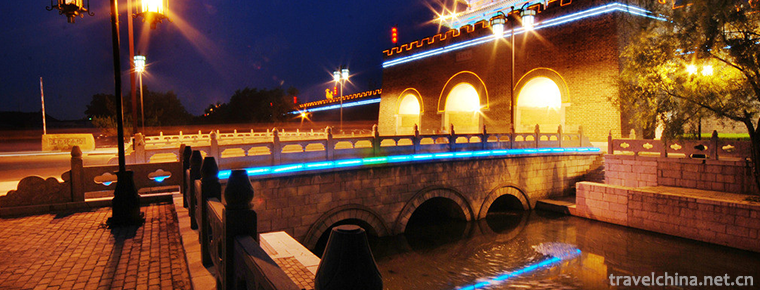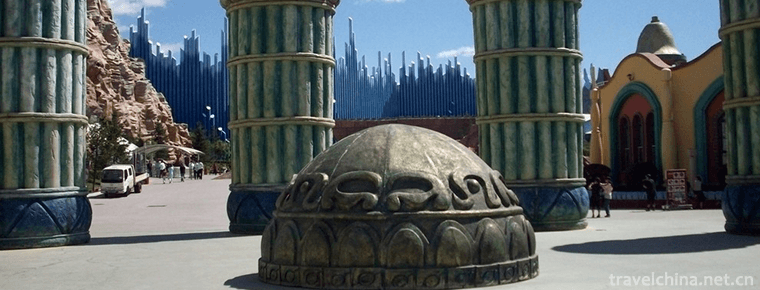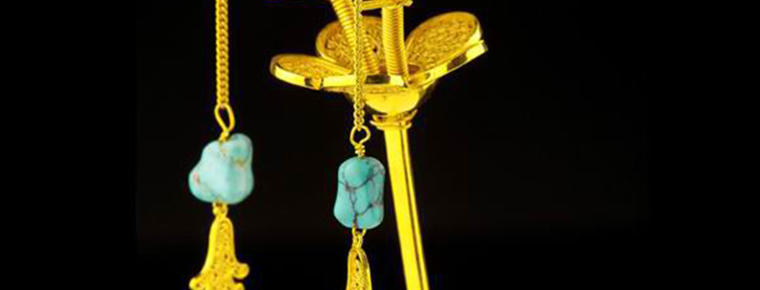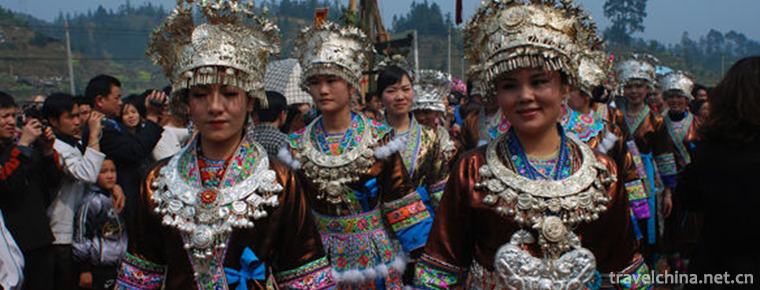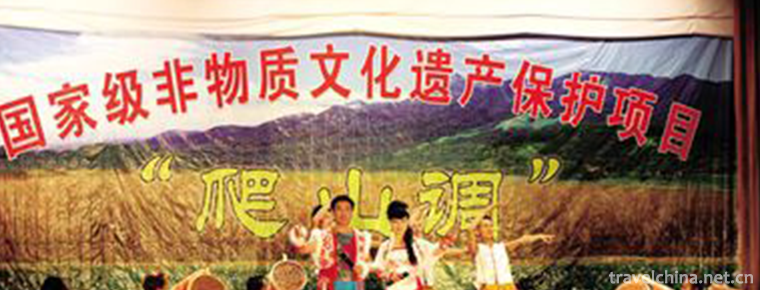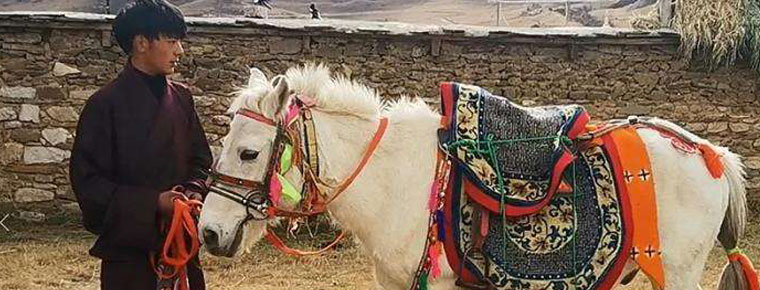Zhaohua ancient city
Zhaohua ancient city
Zhaohua ancient city is located in Zhaohua Town, Zhaohua District, Guangyuan City, Sichuan Province. After that, Zhaochang county was renamed as Yichang county. Located at the confluence of Bailong River, Jialing River and Qingjiang River, the Jialing River flows here with Wancheng water system and natural Taiji. It has the reputation of "the world's first landscape Taiji" natural wonder.
Surrounded by mountains on all sides and surrounded by water on three sides, the ancient city has beautiful mountains and rivers, outstanding people, numerous ancient sites and relics, and simple and elegant folk customs. It is an ideal place for the majority of tourists to sightseeing, leisure and vacation, and archaeology research.
brief introduction
Zhaohua is an important part of Jianmen Shudao site, a national key scenic spot, and a national key cultural relic protection unit. With an area of 20 square kilometers and a total population of 17000, the ancient city was named as a famous historical and cultural town in Sichuan Province by the people's Government of Sichuan Province in 1992. The style of the ancient city remains the same, with rich historical and cultural heritage. On December 10, 2011, Zhaohua ancient city in Zhaohua District of Guangyuan, together with ten ancient towns such as Lijiang in Yunnan Province, won the top ten awards in China on December 10, 2011 at the first "hometown · grand ceremony" jointly organized by China Folk Artists Association, UNESCO Folk Art International Organization (IOV), China agricultural film and television center of CCTV, and China network television station Ancient town award with cultural heritage.
geographical environment
The layout of the ancient city building complex is reasonable. The existing four streets and five alleys are all made of local green sand slate in the style of tile back with three horizontal and two vertical, high in the middle and low on both sides. The streets and alleys are connected by the "Ding" character, which has the military defense characteristics of "the roads are interlinked and the city gates are not opposite". Streets and alleys have a good spatial pattern and pleasant scale. On both sides of the ancient street, there are complete buildings of the Ming and Qing Dynasties, most of which are Chuandou wooden structure, small green tiles and simple northern Sichuan style houses.
There are seven kilometers east of baoniang. Bao was the wife of Guan Suo, the third son of Guan Yu. She fought with the army and was buried here after her death. The tomb was stolen by French archaeologists segaland and lardigue in 1914, and its excavation remains in the Paris museum. But the tomb still exists, the stone is firm, and the interior is dark and inflexible. There is a stone tablet in front of the tomb: "the tomb of Bao family, the wife of Guan Suo, general of Shu Han Dynasty". This is a rare ancient tomb of Han Dynasty.
Outside the east gate of Zhaohua ancient city, where the Jialing River and Bailong River meet, is the famous "jubai ancient ferry" on the Shu Road. In the past, thousands of people held hands during the day and thousands of lights at night. This is the story of Emperor Xuanzong's lucky trip to Shu in the old and new books of Tang Dynasty, "when a couple of fish are carrying a boat across Tianjin, the debater thinks that the dragon" occurs here. It is said that Emperor Ming of Tang Dynasty held a banquet on the South Bank of the ferry for three days, which is still called "banyan dam". "County annals" records that Tang Xizong fled to Sichuan, and then joined at the jubai ferry. The water was sharp and the waves were high, and it was difficult to cross the boat. Because the Bailong River was white and the Jialing River was red, it was at the beginning of the confluence. They still kept their own flow direction and original color, "clear-cut", turbid and indistinct, like two dragons rolling. Du Fu, Yao he, Yue Yu, Yang Shen, Wang Shizhen and other poets of all dynasties have their own poems. There are more than 30 inscriptions on the original Dukou tablets, but few of them can be found. However, what the common people remember most clearly is "the stele on which the magistrate of the Tang county made it easy for him to pull a fiber in the waist wat".
This stele tells that during the reign of emperor Yizong of Tang Dynasty, He Yi, the magistrate of Yichang (now Zhaohua), tied his waist and jacket and inserted wat board in his waist to lead a boat for the spring outing boat of Cui Pu, the governor of Lizhou city. He Yi resisted his immediate superior, Cui Sishi, who, regardless of his busy farming, asked him to catch people to pull boats. The county magistrate's action, shame Cui Chi Shi had to stop the boat tour. Sun Qiao, a Jinshi of the same period, passed by Yichang and inquired about this matter and wrote an article on how easy it is to learn. In this way, the cruel officials who ignored the people's life and death and the decadent official system of the imperial court were mercilessly exposed and castigated. Many of the poem steles of Dukou also praised the magistrate of He county. Zhang Chuanshan's poem in the Qing Dynasty said: "the two rivers still flow around the county. In the Tang Dynasty, there were no couples among the Xianli in ancient times. They only liked to burn the imperial edict on tea. Why did Yaohu go to paint boats. Under the monument, farmers should shed tears, mulberry Yin mulberry wife do not know. Sun Qiao, a Jinshi in Xiantong County, often makes people profit a lot. " The local people are all people's stele, which is said to be a good story for thousands of years.
At the west gate of the ancient city, close to Fei's tomb, there is a "Ding Gong Temple". Ding Gong, the father and son of Ding Gongbao, served as governor of Sichuan Province in Chengdu in the second year of Guangxu. He advocated the famous Sichuan dish "Kung Pao Diced Pork". Ding Jianye, the father of Ding Gongbao, was a county magistrate in Zhaohua. Gong Bao was born here. It is said that his nurse is now from Lishu village, Baolun township. After Ding Gongbao became the governor of Sichuan, he built "Dinggong Temple" in Zhaohua, and the inscription still exists.
History and culture
Zhaohua ancient city is a precious historical scroll, which condenses the continuous history of the establishment of local political power in China. It is one of the earliest counties in China to implement the county system management, and has the reputation of "the first county in Bashu".
Living fossil of ancient city civilization
The ancient city of Zhaohua has a history of more than 4000 years since Tang Yu. Although it has a long history, the ancient city civilization is less impacted by modern civilization. It is the best preserved ancient county town and the only ancient city of the Three Kingdoms. The ruins of the ancient city of qinjiameng after the flood are clear and distinguishable. A large number of ancient sites of the Three Kingdoms, such as the ancient post road, Jiameng ancient pass, Fei Yi tomb, Wuhou Temple, Fei Jing Hou Temple, victory dam, Tianxiong pass, Niutou mountain, Jiang Weijing, jubai ancient ferry, guansuocheng, Bao Sanniang tomb and other national, provincial and municipal cultural relics are still in style and well preserved, which are rare in China. The ancient city wall of Han Dynasty and ancient buildings of ancient city gate, Bagua well and Longmen Academy in Ming and Qing Dynasties are well preserved. Bronze stone tools, boat coffin tombs, Qin pottery and Han bricks have been excavated. The ancient city of Zhaohua is famous for its outstanding people and elegant appearance. Numerous honest and upright officials have left touching stories. Many literati, literati and poets have left countless works handed down from generation to generation, adding a magnificent chapter to the history of China. Fei Yi was the founder of Hanshou City, He Yi was able to take a boat with Ju Baidu, Xu Xin died in the battle of Changling mountain, Wu Zhenqi wrote articles on drama, Zeng Fengji taught people to attach importance to sericulture, and Meng Zhaojian's academy to educate people... This is a story handed down from generation to generation, and everyone respects it. The vicissitudes of Jiameng ancient pass and Tianxiong pass, and the sound of the river in jubai lake, left countless poems of scholars such as Du Fu and Lu you. In memory of Ding Jianye and Ding Baozhen, the father and son of "donating money to buy property and avoiding the man's husband and horse forever", later generations built Dinggong temple at the west gate of the ancient city. The temple meeting was held on April 28 of the lunar calendar. The "Three Kingdoms culture and Art Festival" and "Three Kingdoms Cultural Tourism Festival" are held in the Spring Festival Golden Week and the National Day golden week each year, which have attracted tourists and scholars from all over the world to visit, travel and archaeological research.
According to the records of the Three Kingdoms, the biography of the first lord recorded: "when the first Master arrived at Jiameng in the north, he was able to ask for Lu and build up his kindness to collect the hearts of the people.". In the 17th year of Jian'an (212 A.D.), after Liu Bei arrived at Jiameng, he inspected the terrain and found that it was exactly like the map presented by Zhang Song: "the two rivers of this city converge and go around the east of the city; the ancient road of Jinniu passes through the city; the majestic gate of Jianmen stands beside it; the ancient jubai ferry is a city of bullets, but there is a solid foundation of gold and soup". It is a strategic place. He stationed troops and trained troops in Jian'an 10 In the seventh year (212 A.D.), taking advantage of Cao Cao's attack on the eastern Wu, he adopted Pang Tong's advice and turned away from Jiameng to attack Chengdu on the pretext of helping Dongwu. Liu Zhang was forced to surrender, laying a solid foundation for the establishment of Shu. In the first year of Zhangwu (221 AD), Liu Bei established the kingdom of Shu Han in Chengdu and became emperor zhaolie himself. At that time, Liu Bei, not forgetting Jiameng, an old base, personally took the first and last words from the popular auspicious "Han Zuo Yongshou" (Zuo, meaning the position of the king), and changed Jiameng to Hanshou County. He hoped that the Han Dynasty, which he had created, would coexist with heaven and earth and live with the sun and the moon. Therefore, there is a saying that "Shu Han flourished, Jia sprouted".
After the establishment of the Shuhan regime, Hanshou city was the military supplies transfer base and command center for Zhuge Liang's six expeditions to Qishan and Jiang Wei's nine attacks on the Central Plains. Since the fifth year of Jianxing, Zhuge Liang has been busy on Jiameng ancient Shu Road. In the 19th year of Yanxi (252 AD), Fei Yi was ordered to set up the prime minister's office in Hanshou. After Jiang Wan, he was in charge of the military and political affairs of Shu state. The next year, he was drunk and was killed by Guo Xun, the general of Cao Wei. After his death, he was buried in Hanshou (now Zhaohua). After Fei Yi was killed, Jiang Wei took over the military power of Shu state, but he failed to conquer the Central Plains nine times. In the winter of the fourth year of Jingyuan (Annals of the Three Kingdoms, Zhonghui Zhuan), the state of Wei attacked Shu Han with three armies. Jiang Wei retreated to Jianmen pass. He wanted to resist the enemy by virtue of the natural danger of Jianmen pass. Zhang Yi, general of the left chariot, Dong Jue, general of the auxiliary state, and Hu Ji, Guan Suo, the garrison generals of Jiameng yuan, were sent to defend Hanshou (Zhaohua) together. At the same time, Zhong Hui, the general of Wei Dynasty, set out to cross the Jialing River and seize the city of Hanshou. The two armies had a lot of fierce battles. The wife of Guan Suo, Bao Sanniang, died in this battle. After her death, she was buried in the northern suburb of Zhaohua city. The tomb of Bao Sanniang has been preserved to this day. In November 263 A.D., "from Yi and Jue Fu to Han Shou, Wei and Hua retreated from Yin and Ping. When they were suitable for Yi and Jue, they all withdrew from Baojian pavilion to refuse the meeting.". In the 42nd year of Mian Han Dynasty, Zhu Ge's regime was destroyed and Liu zhanhan's army was defeated. Although the Shuhan regime was destroyed, the ancient city of Zhaohua recorded the rise and fall of Shu Han and the legends and sites left behind, which provided rich historical materials for the study of the Three Kingdoms culture. Therefore, there are: "when Shu Han flourished, Jia sprouted; when Shu Han died, Jia sprouted." It's a folk rumor.
In July 2004, Professor Ruan Yisan, director of the research center of China's historical and cultural city, Shanghai Tongji University, evaluated the ancient city's architecture as follows: eight character gate head, vertical arch, blue stone column foundation, wooden column and Xuandong; three sides of the outline, door and window lattice, well carved, ancient and simple decoration, with merchant mansions and historical stories. In 2003, Yuanba District Committee and government adhered to the principle of "protection first and rational utilization" in the restoration of the ancient city of Zhaohua. Professors from Sichuan University and Tongji University were invited to guide the restoration of the ancient city for many times. In the process of construction, careful construction was carried out to restore the original architectural style of the ancient city. After several years of careful construction and restoration, the overall appearance of Zhaohua ancient city has been obtained In an all-round recovery, an ancient city displaying the prosperity and glory of the past is now in front of the world again.
folk culture
Zhaohua ancient city, thousands of years of ancient civilization has nurtured a large number of folk customs and folk culture, with nearly 20 kinds of traditional festivals and customs, such as Chuanzhu temple fair, City God meeting, Niangniang meeting, lion dance, ox lantern, lotus picking boat, walking high feet, playing suona, Crying Marriage and so on; originated from the widely spread local "Zhang Fei Tiao Deng night battle Ma Chao", He Yi's "waist wat pull fiber", Tang Ming emperor's banquet, dam banquet and Jiang Weibing There are more than 30 legends such as trapped Niutou mountain. There are more than 200 famous Zhaohua songs, such as "mother send son", "marriage song", which are widely spread among the people. In particular, Zhaohua's tiyang opera is known as a living fossil of ancient drama. This opera is a kind of Nuo sacrifice activity, which is mainly to honor gods and make wishes. It is a comprehensive art with religious and local characteristics. It has been rooted in the folk for a long time and is loved by local people. It is divided into two parts: Tianxi and Dixi. "Tianxi" mainly uses puppets to perform the thirty-two gods of heaven, while "earth opera" is performed by people dressed up and wearing wooden masks. Most of the plays are traditional myths, such as Monkey King making a scene in the sky, seven fairies coming down to earth, Meng Jiangnu crying the Great Wall, etc., which have attracted many tourists and audiences to enjoy and travel for many years.
Main attractions
Zhaohua ancient city is located on Jianmen Shu Road, a world wonder. The total length of the ancient Shu Road in Zhaohua ancient city scenic area is more than 50 kilometers. It is like a green dragon circling between the mountains and mountains. The green cloud corridor on both sides of the ancient Shu Road forms a unique green corridor in the world.
Zhaohua ancient city has the national monopoly resources of the Three Kingdoms culture -- Fei's tomb and Bao Sanniang's tomb. At the same time, Zhaohua ancient city is also an important birthplace of the Three Kingdoms culture. It is an important example to study the politics, military and economic culture of Shuhan, and is the witness of the rise and fall of the Shuhan regime.
The natural landscape of Zhaohua ancient city is peculiar. Niutou mountain and Yuntai Mountain are cut and chopped with knives and axes. The ancient city is located at the intersection of Jialing River and Bailong River. Taiji is formed by nature, forming the natural wonder of "the first mountain and water Taiji in the world".
Zhaohua ancient city scenic spot is one of the earliest counties in ancient China to implement the county system management, which is worthy of the name of "the first county in Bashu". The same place of the ancient city has experienced the continuous history of the establishment of local government in China, which is very rare in China.
Zhaohua ancient city is a living fossil city established in China. The ancient city has a history of more than 2300 years. It is one of the earliest counties to implement the county system management in ancient China. It is worthy of the name of "the first county in Bashu". At the same time, the ancient city of Zhaohua was changed into Zhaohua town from the capital of juhou state in the period of slavery to the important counties and counties of Shuhan in Qin, Han and Three Kingdoms, to the important counties on the ancient post road of Sichuan in Tang, song, yuan, Ming and Qing Dynasties, and then to Zhaohua County in the Republic of China and new China since 1953. It has experienced the continuous construction history of local government in the same place, which is very rare in China.
Zhaohua ancient city has the most complete preservation of cultural resources of the Three Kingdoms, such as Fei Yi tomb and Bao Sanniang tomb. In 252 A.D., Fei Yi, an important official of the Shu Han Dynasty, was ordered to open his house in Hanshou (Zhaohua). Later, he was drunk and was killed by Guo Xun, a descendant. He was buried here after his death. Fei Yi's tomb and Bao Sanniang's tomb are still well preserved. The sites and relic groups of the Three Kingdoms, such as victory dam, Niutoushan, jiangweijing, guansuocheng, jiamengguan and tianxiongguan, are well preserved and witness the rise and fall of Shuhan regime. At the same time, Zhaohua ancient city is an important birthplace of the Three Kingdoms culture. Liu Bei, the former leader, once built a base for the establishment of the Shuhan political power. Since the fifth year of Jianxing, Zhuge Liang has been busy on Jiameng ancient Shu Road. In the late Shu Han Dynasty, Fei Yi presided over the military and political affairs in Central Sichuan. He was ordered to set up a prime minister's office in Zhaohua to resist the army of the state of Wei. Zhang Fei held the lantern to fight Ma Chao in the victory over the dam, which is said to be a good story for thousands of years. Jiang Weibing was trapped in Niutou mountain, leaving an amazing "worship pool". There are also remains of Wuhou Temple and Guandi temple in the ancient city. The relics, customs and folklore of Shu Han have a long history, and the culture of the Three Kingdoms has a far-reaching influence. Yang Rudai, former vice chairman of the National Committee of the Chinese people's Political Consultative Conference (CPPCC), wrote the inscription "the important town of the Three Kingdoms" passionately during his inspection in the ancient city of Zhaohua. Luo Zhewen, a famous Chinese ancient architecture expert and vice chairman of the Chinese Committee of the World Heritage Management Committee, excitedly pointed out that "the ancient city of Zhaohua has many sites of the Three Kingdoms, which highlights the rich connotation of the Shu Han culture of the Three Kingdoms. It is an important example of studying the politics, military and economic culture of the Shu Han Dynasty, which is very precious.".
Zhaohua ancient city scenic spot is not only famous for its rich historical relics, but also famous for its rich historical relics and unique and beautiful scenery. The Bailong River and Jialing River meet here, forming a natural landscape Taiji map with a diameter of about 5 km and an area of 20 km2. The ancient city is located at the Yang eye of the landscape Taiji, and has the reputation of "the world's first landscape Taiji" natural wonder. Niutou mountain, Yuntai Mountain, precipice, knife cutting axe, like a giant stone prop, standing between heaven and earth.
"Come out of the window along the mountain trees, and the sound of the river sleeps by all night." This is the ancient poet's admiration for the beautiful scenery of Zhaohua ancient city. Bailong River, Jialing River, Niutoushan mountain, ancient post road, Tianxiong pass, and natural wonders of Taiji mountain and water constitute the magnificent picture of Zhaohua ancient city. The ancient city is surrounded by mountains on all sides and faces water on three sides. Bailong River and Jialing River meet here, forming a natural landscape Taiji map with a diameter of about 5 km and an area of about 20 km2. The ancient city is located at the fish eye of the anode of the mountain and water Taiji, which has the reputation of "No.1 landscape Taiji in the world". The ancient city has unique mountains and charming scenery. It is located in Yishan mountain in the northwest of the ancient city. The mountain shape is steep in the north and gentle in the south. It is the place where the dragon vein of the ancient city is located. Climbing on the Yishan mountain, you can master the Fengshui pattern of the ancient city and feel its aura. Bijia mountain, located in the southeast of the ancient city, is covered with green trees and beautiful mountains. Maoping night moon is one of the eight sceneries of Zhaohua in ancient times Niutou mountain, Yuntai Mountain, knife cutting and axe chopping, towering into the clouds, like a giant stone pillar, standing between the heaven and the earth. The mountain vegetation is rich, the forest is luxuriant, secluded like Qingcheng, beautiful like Emei. Guangyuan Mountaineering Association built the mountaineering base here, attracting many tourists and mountaineering enthusiasts to come to enjoy the world's first natural wonders of mountains and rivers Taiji, and experience the essence of the unity of man and nature. You can also search for the ancient battlefield of the Three Kingdoms, hunt wolf smoke, and feel the solemn and stirring of "rolling Yangtze River, passing water in the East, and sweeping away heroes by waves". At the same time, the water transportation of the ancient city is "extended in all directions". Visitors can not only enjoy the beautiful scenery of Bailong River and Jialing River by boating in clear water and green water, but also fish and fish on the river to taste the fruits of victory. You can also enjoy the night scene of the ancient city in the dusk of the night and the singing of the evening music by fishing boats. It seems that you can enter the fairyland of the world. There is neither the noise of big cities nor the pollution of industrial waste water and waste gas around the ancient city, so it is the best place for tourists to have a holiday and sightseeing.
Zhaohua ancient city scenic spot all kinds of cultural connotation reappearance lifelike, the tourist participation interaction.
Bagua well: built in the Ming Dynasty, the well water is sweet and delicious. It is one of the existing complete ancient wells in the ancient city. In order to pray for the well to be full, the well wall and bottom are all in the shape of eight trigrams, so it is called "Bagua well". The stone pits of different sizes and depths beside the well were formed over the years by people placing copper coins.
tourist guide
delicious food
Bamboo fungus and fungus dishes
There are two specialties in Qingchuan County of Guangyuan. One is Dictyophora and the other is Auricularia auricula. Dictyophora, also known as "fungus Queen" and "plant chicken", is also known as "fungus Queen" and "plant chicken". Because of its high growth characteristics and nutritional value, it is as famous as Tremella fuciformis, which can not be compared with the same kind of Auricularia auricula. Therefore, when you go to any restaurant in Guangyuan, you should not forget to order the dishes of Dictyophora and Auricularia auricula, such as tomato and Dictyophora, mushroom soup of Dictyophora, black fungus with pickled pepper, and fried meat with agaric.
Steamed cold noodles
The queen steamed cold noodles are also called "husband and wife rice cold noodles". It is said that before entering the palace, Wu Meiniang often visited the river bend with Chang Jianfeng, her childhood sweetheart. There is a noodle shop at Hewan ferry. They always go to the shop to eat a bowl of noodles. Therefore, they often discuss the production of noodles with shop owners. They think that it would be better to have a kind of cold noodles in summer. So he experimented with the noodle shop master, and finally developed a soft, delicious, soft and non sticky rice cold noodles with rice pulp. Meiniang and Jianfeng were so happy that they hugged each other. When the master of the noodle shop saw the scene, he teased the couple: "it's better to call it husband and wife's rice cold noodles!" It happened to be Meiniang's birthday, and the husband and wife mi Liangmian was born. And thus spread, become the local people love to eat the local famous food. Later, Wu Meiniang was selected by Emperor Taizong of the Tang Dynasty as a talented person. She had to go to Chang'an, capital city, because her life was hard to disobey. Until Wu Meiniang became the empress, she never forgot "husband and wife rice cold noodles". On her birthday, she ordered the imperial chef to cook a bowl of food for her until her birthday. The steamed cold noodles are made from old rice and leftovers. They are chewy and refreshing. The most common way to eat them is to put cold noodles in a bowl, add soy sauce, vinegar, chili, chili oil, sesame oil, sugar, pepper flour, garlic puree and other seasonings. After mixing, there are five flavors: sour, sweet, hemp, spicy and fragrant, and Sichuan flavor is full.
Jianmen tofu
To Guangyuan, Jiange is a must go place, here is the famous Jianmen tofu. Jianmen tofu has a long history. There was a legend that Jiang Wei used local materials to grind tofu to reward officers and soldiers when he was guarding Jiange. Jianmen bean curd is made from CONGLOMERATIC oil sand and stone soil in Jianmen mountain area. It is made by soaking beans, grinding pulp, filtering residue, boiling pulp, spotting pulp, dehydrating and so on. Hundreds of dishes can be made by frying, frying, frying, burning, stewing, steaming, boiling, cold mixing and other cooking methods. The famous one is water chestnut bean curd.

-
Kuan and Zhai Alley
No. 127, ChangShun Street, Qingyang, Chengdu, Sichuan, China.
Views: 228 Time 2018-09-29 -
Baoxiangsi Scenic Area
Baoxiang Temple scenic spot is located in the northwest corner of Wenshang County. It is a famous Buddhist cultural tourist resort in China. Baoxiang Temple scenic spot is a national AAAA level scenic.
Views: 102 Time 2019-01-02 -
Jizu Mountain Scenic Spot in Binchuan
Jizu Mountain is located in a cave-making area about 20 kilometers west of Binchuan County, Yunnan Province, 90 kilometers away from Dali City. It is named for its three peaks in the front and a ridge.
Views: 140 Time 2019-01-03 -
88 Floor Sightseeing Hall of Jinmao Building
Jinmao Tower's 88th floor sightseeing hall, located in Shanghai, China, has a height of 340.1 meters and an area of 1520 square meters. It is the largest sightseeing hall in China at present. It is th.
Views: 1600 Time 2019-01-26 -
Sankong Tourist Area in the Old City of the Ming Dynasty
Qufuming Old City Tourist Area in Jining: World Cultural Heritage, one of the three holy cities in the world, national AAAAA-level tourist attractions, National Scenic spots.
Views: 241 Time 2019-02-07 -
Zhangye Great Buddhist Temple
The Great Buddha Temple was built in the first year of Yongan, Xia Dynasty (1098), formerly known as the Kaye Tathagata Temple, in the ninth year of Yongle, Ming Dynasty (1411), and in the seventeenth.
Views: 171 Time 2019-03-16 -
Changying Century City
Changying Century City, located in Nanguan District, Changchun City, Jilin Province, was founded in 2003. It is a comprehensive tourist area integrating science and technology, adventure, performing a.
Views: 206 Time 2019-03-17 -
Making Skills of Filament Mosaic
Silk mosaic is one of the traditional handicraft techniques in China. Gold, silver and copper are drawn into silk, and various decorations such as jewelry and utensils are made by various techniques..
Views: 138 Time 2019-05-04 -
Miao Series Slope Cluster
Miao Series Slope Club refers to the festival activities of villages and villages in Rongshui County, Guangxi Zhuang Autonomous Region during the period from the third to seventeenth day of the first .
Views: 149 Time 2019-06-05 -
A tune of mountain climbing
Mountain climbing tune, also known as mountain climbing song and mountain song, is a traditional short-tune folk song popular in the agricultural and semi-agricultural and semi-pastoral areas of centr.
Views: 170 Time 2019-06-08 -
Mianzhu Hanwang earthquake site
Mianzhu Hanwang earthquake site (Park) is composed of three areas: Dongqi factory area, Dongqi dormitory area and Hanwang town area. It mainly focuses on four themes: digital display platform.
Views: 211 Time 2020-11-05 -
Can Ding Zhens Pony pearl really run first
Recently, after the exposure of Ding Zhen's Pony pearl, many netizens have a question in their hearts: "can it really run first?"? After the news release, netizens have been hotly debated. The specific contents are as follows:.
Views: 131 Time 2020-12-07
